Bimetal radiators are an excellent solution for indoor installation. They are highly energy efficient and can last for many years.
The main characteristics of bimetallic radiators:
- The power of one section is from 150 to 190 W, depending on the manufacturer. This information will be needed for further calculation.
- Service life - about 20 years.
- High heat transfer, in this parameter the devices are superior to cast-iron counterparts.
Four-section bimetallic radiator
Many people purchase bimetallic heating radiators, how to calculate the number of sections for this device, what factors should be taken into account? You should talk about this in detail, and talk about the main methods.
Proper calculation is the basis for comfortable living in an apartment or house. Depends on it:
- Room temperature. A small number of sections will not be able to provide heating. If too many of them are installed, then the air will become dry enough, the room will be incredibly hot.
- Possible expenses for the purchase of heating appliances. The more sections in the batteries, the more expensive they will cost you.
- Overall efficiency of the heating system.
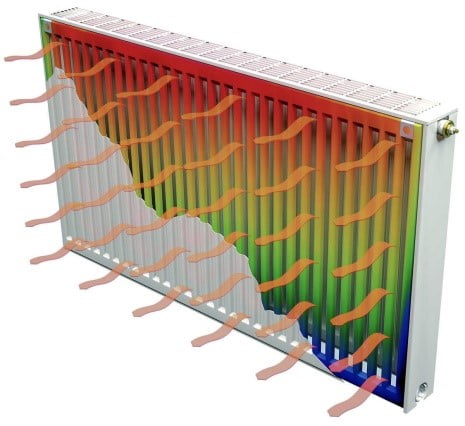
Heat distribution in the radiator
Important! All calculations are always considered approximate. When taking into account the accompanying factors, you can slightly reduce the error, but in any case you will not get accurate parameters.
Important parameters
The calculation of bimetallic radiators is a complex and responsible process. It is necessary to take into account a number of factors that may affect its implementation, among them:
- The presence of ventilation in the room implies an increase in power. Through this system, part of the heat is removed from the room, which negatively affects the overall efficiency.
- If steam is used in the system, then the actual heat transfer is significantly increased.
- Corner rooms are always colder, they have street walls, the calculations will have to be increased.
- If double-glazed windows are installed in the room, they will retain heat better.
- Bimetal has a sufficiently high thermal conductivity, the power of the section can be obtained from the manufacturer in advance.
- The use of thermal insulation for walls significantly reduces heat loss.
- Be sure to take into account the minimum winter temperatures, they depend on the region of residence.
- The coolant in the standard system moves from top to bottom, this option allows you to increase the real efficiency.
- Do not use batteries more than 10 sections when connected on one side. Water will not be able to reach the last elements, their efficiency will tend to zero. If more than 10 sections are placed in one bimetallic radiator, then a two-way connection will be required.
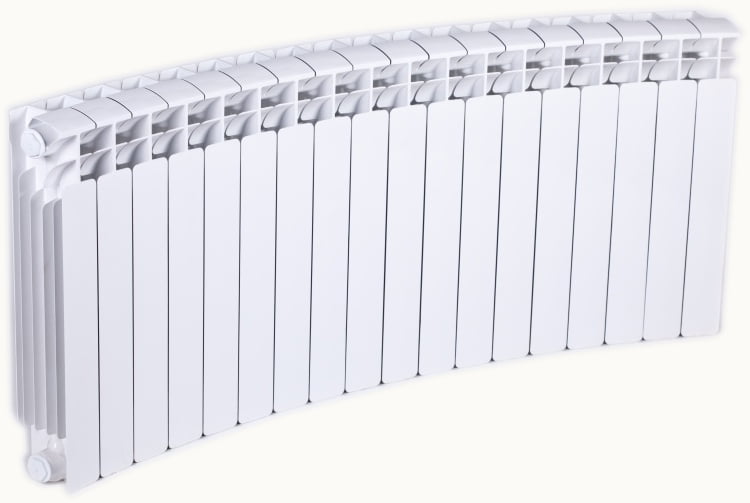
Long bimetal batteries can only be installed with double-sided connection
If you take into account all these factors during the preparation of calculations, you will be able to obtain more accurate data and eliminate the decrease in the efficiency of the heating system.
Important! When choosing a scheme for calculation, pay attention to the height of the ceilings. For standard apartments, you can use the method by area, for rooms with a height of 3 meters or more, you must use the method by volume.
Basic Methods
- By area of the room.
- By volume.
- With additional coefficients.
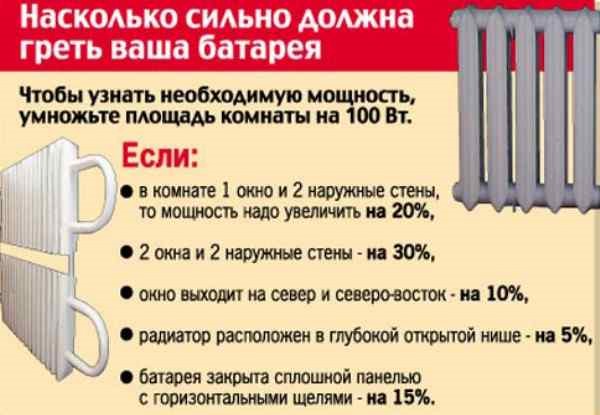
Mini-instruction for choosing a radiator
Each method has its own advantages and disadvantages. The simplest is the calculation by area or volume, it will take a little time. The use of coefficients allows you to increase the accuracy and take into account all possible factors.
By area
This is the easiest method, but should only be used for rooms with a ceiling height of 2.4 to 3 meters. Otherwise, a serious distortion of the results obtained may occur.
According to current standards, at least 100 W of heating power must fall on one square meter of area. This parameter will need to be taken into account during the calculations.
How this process goes:
- First you need to look through the documents and the technical passport, they indicate the area of the room. If you do not have the opportunity to obtain such information, then you need to measure the length and width, multiply them, and you will get the required indicators.
- Let's say the area of the room is 10 squares. Then you need 10 * 100 W, we get the total power of all sections in 1000 W.
- We select the model of a bimetallic radiator, find out in the characteristics the power of one section. For example, it is equal to 150 watts. It will be necessary to divide the total power into the parameters of one element, 1000/150 = 6.66. We round up to 7 sections per room, they can fit in one heater.
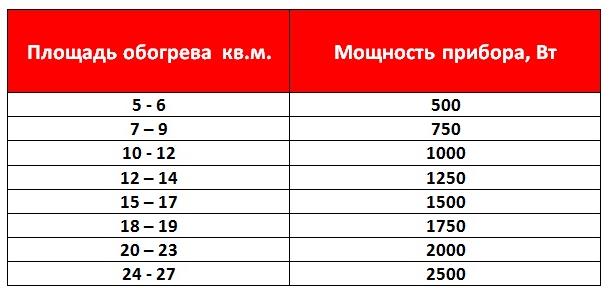
Table of area versus volume
Do not forget about additional factors that may affect the calculation process. If the apartment is angular, it has a balcony, then feel free to add another 20 percent to the results.
By volume
If the room is high enough, then the calculation is best done by volume. This option should be used for ceilings from 3 meters, its use can significantly reduce errors.
Sanitary standards depend on the type of house. Panel buildings have increased heat losses, at least 41 W per 1 cubic meter. Modern houses with insulated walls and double-glazed windows lose much less heat, for them the norm is 34 watts.
How is the direct calculation performed:
- We find out the area and height of the room from the documents, or we take measurements.
- For example, the area is 20 squares, the ceiling height is 3 meters. Multiplying these parameters, we get 60 m 3.
- You need to multiply the volume by the standard, that is, 60 * 41 \u003d 2460 watts. This is full power for all sections.
- We divide the resulting parameter by the power of one element. Therefore, 2460/150=16.4. Rounding up, we get 16 sections.
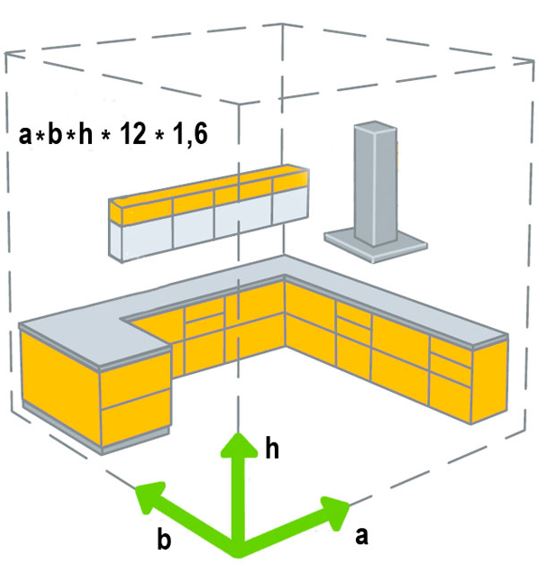
Calculation of heat by room volume
The resulting 16 sections are not the final parameter. If increased heat loss is observed in the room, it has external walls, a balcony, the battery is placed in a niche, then another 20-40 percent will need to be added to the result. The number of sections should be divided into 2 - 3 bimetallic radiators to increase the efficiency of the system.
By the method of coefficients
If you want to get the most accurate parameters, then this method will suit you. The calculation is carried out using the area of the room and additional coefficients according to the formula:
CT = 100W/sq.m. * P * K1 * K2 * K3 * K4 * K5 * K6 * K7
In this equation, P means the area of \u200b\u200bthe room for which the calculation is carried out. K1 is the glazing of the room, the type of double-glazed windows. K2 - a parameter indicating the thermal insulation of the walls in the house. K3 - the ratio of the parameters of the area of \u200b\u200bwindows and rooms. K4 depends on the average air temperature in the cold season. K5 is used to adjust the power of the system, taking into account the number of street walls. K6 depends on the type of room that is located above the room. K7 is determined taking into account the height of the ceilings.
After calculations, we get the total power of the system, it must be divided by the parameters of one element of the bimetallic radiator. As a result, we get the number of sections for all heaters in the room.
Accurate count
All of the above methods for calculating the number of sections of bimetallic radiators are approximate. There are formulas for accurate calculation. They take into account a variety of factors:
- Room height.
- Thermal insulation parameters of walls and windows (up to 70% of heat loss occurs through windows).
- The frequency with which doors or windows are opened (especially relevant for offices and shops).
- heating system attributes.
- Average seasonal temperature in the region.
- The most frequent wind direction and so on.
For all this, there are special services on the sites, but often there is no opportunity or desire to scrupulously find out all the details. In most cases, you can limit yourself to approximate data.
Watch a short video on how the required power of radiators is calculated according to regulatory documents:
When building a house, people are wondering how to calculate the number of heating radiator sections? Insufficient number of sections will not warm the room to comfort.
